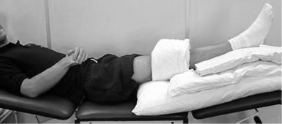Ice and heat treatment
This page provides information about using ice and heat in the treatment of soft tissue injuries.
Why use ice?
With any sprain, strain or bruise there is some bleeding into the underlying tissue which causes pain and swelling. Using ice immediately after the injury will help to limit the body's response to injury, the ice will:
- reduce bleeding into the tissues
- prevent or reduce swelling (inflammation)
- reduce muscle pain and spasm
Using ice treatment every 2 hours (when awake) for the first 24 to 48 hours after an injury will give the best results.
Ice may also be used to ease the pain in the lower back and long-term problems such as arthritis.
Making an ice pack
To make an ice pack you will need:
- a plastic bag (without any holes)
- crushed or cubed ice
- a small towel, tea towel or cloth
Place the ice into the plastic bag, squeeze out all of the air then seal it tightly.
Alternatively, you can use a bag of frozen vegetables as an ice pack, which can be kept in the freezer for this purpose.
Ice packs can also be purchased but it is important to follow the instructions carefully.
Applying an ice pack
Dampen the towel or cloth and place it on to the area where you will be putting the ice pack.
Place the ice pack on top of the damp cloth and hold it in place firmly with your hands or a bandage.
If your injury is recent and has happened in the last 24 to 48 hours, elevate (raise) the limb above the level of your heart, as in the picture below.

Figure 1: Raise the limb above the level of your heart
You can also do this with an arm injury by lifting the arm gently on to pillows, above the level of your heart, while either in a lying or sitting position.
Elevation of the injured area limits swelling, as it helps the return of tissue fluids to the body.
If the ice pack is placed over a large, muscular area, such as the thigh, it can be kept on the area for up to 20 minutes.
If the ice pack is placed over a small, bony area, such as the ankle, it should stay on the area for 10 to 15 minutes.
The skin will normally become red and cold.
Remember to check the skin underneath the ice pack every 5 minutes for:
- blueness of the skin
- blotchy and painful skin
- excessive numbness
If you get any of these symptoms remove the ice pack straight away.
Precautions
- Never put an ice pack directly onto your skin. Always place a damp cloth on your skin then the ice pack.
- Only use an ice pack on areas where you have normal skin sensation and normal circulation.
- Never put an ice pack over an open wound or graze.
- Ice packs may be used for children’s injuries but must be under supervision and for reduced times.
When to use heat treatment
When an injury is over 2 days old, heat can be applied in the form of a wheat bag, heat pad, deep heat cream, hot water bottle or a bath. Heat causes the blood vessels to open wide (dilate) which delivers more blood into the area to help the healing of damaged tissues.
Heat also soothes or relieves pain and spasm leading to less stiffness. If heat is applied to the skin, it should not be hot; gentle warmth will be enough. A towel can be placed between the heat source and the skin for protection. The skin must be checked at regular intervals.
Do not use heat on a new injury because it may make the problem worse. The exception to this is when you have a new lower back strain. A lot of the pain in this case is caused by muscle spasm rather than tissue damage, so heat is often more helpful than ice.
Ice gives a longer-lasting effect on the circulation and the pain-relieving properties are deeper than heat.
Both heat and ice can be re-applied after an hour if needed.
Contact information
For more information about managing your injury, please contact:
Physio call back
Gloucestershire Royal Hospital
Tel: 0300 422 8527
Monday to Friday, 7:30 am to 5:30 pm
Cheltenham General Hospital
Tel: 0300 422 3040
Monday to Friday, 8:00 am to 5:00 pm